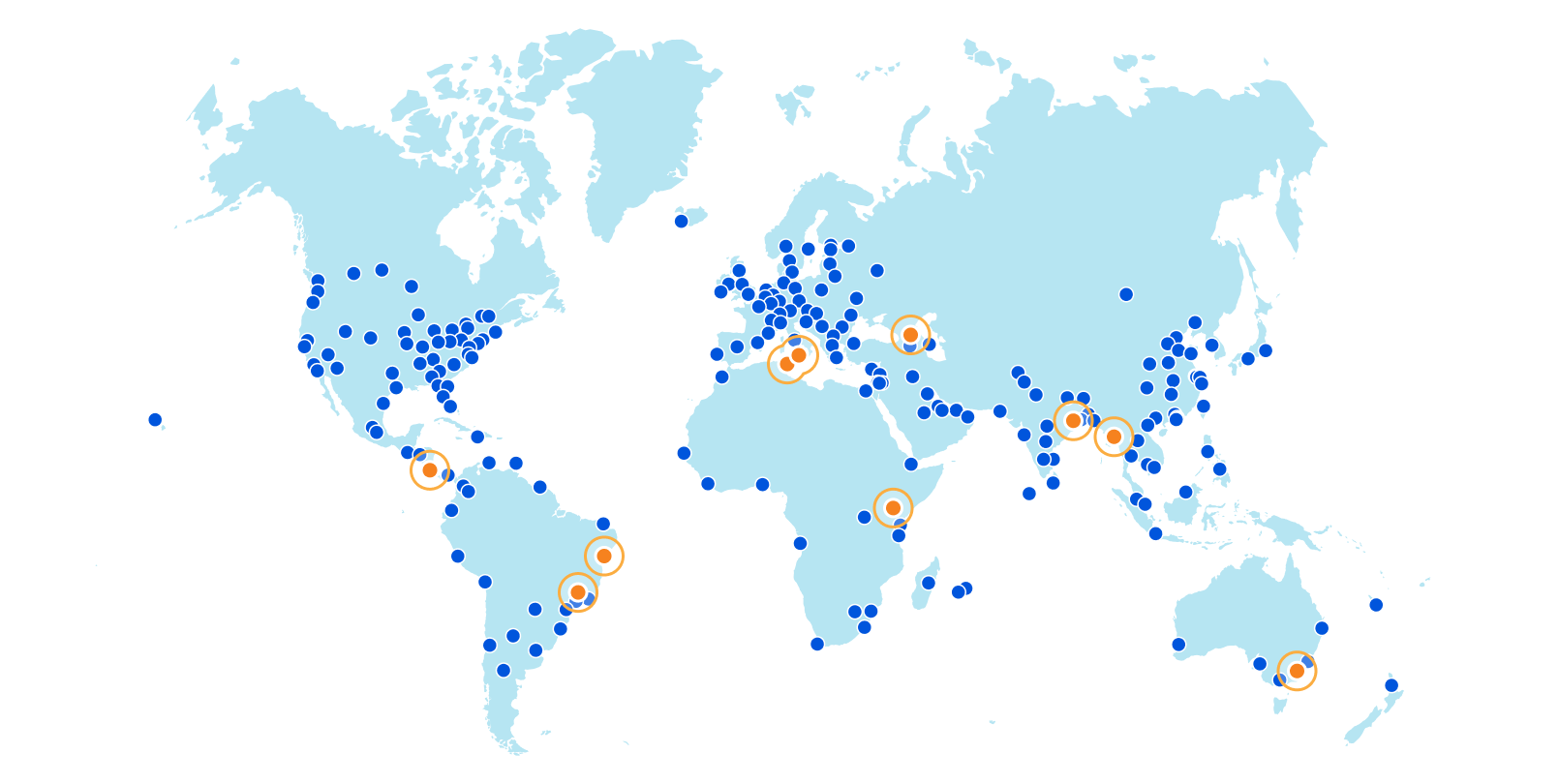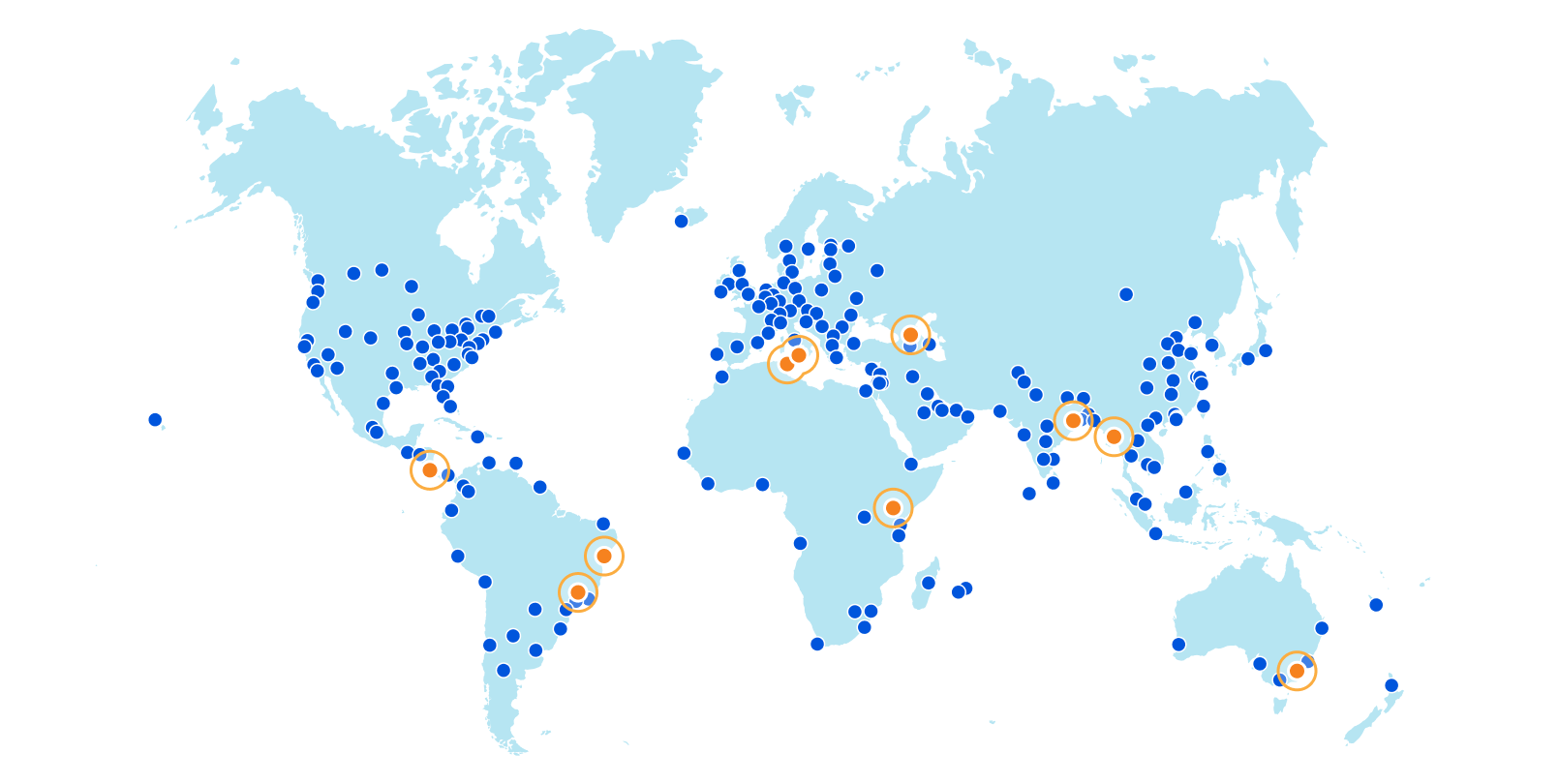Cloudflare’s Network Doubles CPU Capacity and Expands Into Ten New Cities in Four New Countries


Cloudflare’s global network is always expanding, and 2021 has been no exception. Today, I’m happy to give a mid-year update: we've added ten new Cloudflare cities, with four new countries represented among them. And we've doubled our computational footprint since the start of pandemic-related lockdowns.
No matter what else we do at Cloudflare, constant expansion of our infrastructure to new places is a requirement to help build a better Internet. 2021, like 2020, has been a difficult time to be a global network — from semiconductor shortages to supply-chain disruptions — but regardless, we have continued to expand throughout the entire globe, experimenting with technologies like ARM, ASICs, and Nvidia all the way.
The Cities

Without further ado, here are the new Cloudflare cities: Tbilisi, Georgia; San José, Costa Rica; Tunis, Tunisia; Yangon, Myanmar; Nairobi, Kenya; Jashore, Bangladesh; Canberra, Australia; Palermo, Italy; and Salvador and Campinas, Brazil.
These deployments are spread across every continent except Antarctica.
We’ve solidified our presence in every country of the Caucuses with our first deployment in the country of Georgia in the capital city of Tbilisi. And on the other side of the world, we’ve Continue reading
Getting SASE? Four Guidelines for Success
The larger and more diverse your infrastructure, the more your SASE approach will need to deliver all the security you require now without limiting your options for the future.Thank You for Everything Irena, We’ll Miss You Badly
In February 2018, Irena Marčetič joined ipSpace.net to fix the (lack of) marketing. After getting that done, she quickly took over most of sales, support, logistics, content production, guest speaker coordination… If you needed anything from us in the last few years, it was probably Irena answering your requests and helping you out.
She did a fantastic job and transformed ipSpace.net from Ivan and an occasional guest speaker to a finely tuned machine producing several hours of new content every month. She organized our courses, worked with guest speakers, podcast guests and hosts, participated in every guest speaker webinar to take notes for the editing process, managed content editing, watched every single video we created before it was published to make sure the audio was of acceptable quality and all the bloopers were removed… while answering crazy emails like I need you to fill in this Excel spreadsheet with your company data because I cannot copy-paste that information from your web site myself and solving whatever challenges our customers faced.
Unfortunately, Irena decided to go back to pure marketing and is leaving ipSpace.net today. Thanks a million for all the great work – we’ll badly miss you.
Thank You for Everything Irena, We’ll Miss You Badly
In February 2018, Irena Marčetič joined ipSpace.net to fix the (lack of) marketing. After getting that done, she quickly took over most of sales, support, logistics, content production, guest speaker coordination… If you needed anything from us in the last few years, it was probably Irena answering your requests and helping you out.
She did a fantastic job and transformed ipSpace.net from Ivan and an occasional guest speaker to a finely tuned machine producing several hours of new content every month. She organized our courses, worked with guest speakers, podcast guests and hosts, participated in every guest speaker webinar to take notes for the editing process, managed content editing, watched every single video we created before it was published to make sure the audio was of acceptable quality and all the bloopers were removed… while answering crazy emails like I need you to fill in this Excel spreadsheet with your company data because I cannot copy-paste that information from your web site myself and solving whatever challenges our customers faced.
Unfortunately, Irena decided to go back to pure marketing and is leaving ipSpace.net today. Thanks a million for all the great work – we’ll badly miss you.
Full Stack Journey 055: Application Migration And Kubernetes
Are application migrations still a thing in the cloud-native world? In this episode of the Full Stack Journey podcast, host Scott Lowe is joined by Nicholas Lane, Staff Engineer on the Kubernetes platform team at Wayfair, to discuss application migrations in a Kubernetes environment.
The post Full Stack Journey 055: Application Migration And Kubernetes appeared first on Packet Pushers.
Full Stack Journey 055: Application Migration And Kubernetes
Are application migrations still a thing in the cloud-native world? In this episode of the Full Stack Journey podcast, host Scott Lowe is joined by Nicholas Lane, Staff Engineer on the Kubernetes platform team at Wayfair, to discuss application migrations in a Kubernetes environment.How Routers Really Work Live Webinar
I’m teaching a webinar on router internals through Pearson (Safari Books Online) on the 23rd of July. From the abstract—
A network device—such as a router, switch, or firewall—is often seen as a single “thing,” an abstract appliance that is purchased, deployed, managed, and removed from service as a single unit. While network devices do connect to other devices, receiving and forwarding packets and participating in a unified control plane, they are not seen as a “system” in themselves.
Introduction Into Insider Threat and Mitigation Best Practices
Your staff members may fail to notice how they expose their business to security risks. Beware of the most common insider threats and learn how to resist.95th percentile and other bandwidth metering methods
There is a lot of confusion around the 95th percentile bandwidth metering. Therefore this blog posting is intended to provide you with
The post 95th percentile and other bandwidth metering methods appeared first on Noction.
Details and Complexity
What is the first thing almost every training course in routing protocols begin with? Building adjacencies. What is considered the “deep stuff” in routing protocols? Knowing packet formats and processes down to the bit level. What is considered the place where the rubber meets the road? How to configure the protocol.
I’m not trying to cast aspersions at widely available training, but I sense we have this all wrong—and this is a sense I’ve had ever since my first book was released in 1999. It’s always hard for me to put my finger on why I consider this way of thinking about network engineering less-than-optimal, or why we approach training this way.
This, however, is one thing I think is going on here—
We believe that by knowing ever-deeper reaches of detail about a protocol, we are not only more educated engineers, but we will be able to make better decisions in the design and troubleshooting spaces.
To some degree, we think we are managing the Continue reading
The Week in Internet News: EU Launches Antitrust Investigation of Google

Competing for ads: The European Union has launched an antitrust investigation of Google’s advertising practices, with investigators looking into whether the company favored its own online advertising technology, CNBC reports. The probe will look into whether made it harder for other online advertising services to compete. Blocking the ads: In a related story, Google has […]
The post The Week in Internet News: EU Launches Antitrust Investigation of Google appeared first on Internet Society.
There Is No Such Thing as Innovation Without Automation
Cloud offers great opportunities to be innovative. But you can’t be innovative without being agile, and you can’t be agile without automation.What Makes A Senior IT Engineer “Senior”?
Ravi asks the following…
I’m trying to figure out what makes a network engineer truly a “senior” engineer. What skills, mostly non-technical, do they possess in order to bring value to the work place?
I’ll share my opinions based on my experience having held junior and senior IT engineering roles, as well as multiple managerial stints with engineers as direct reports. I’m mostly going to address IT engineering broadly rather than networking specifically, as my opinion is the same no matter which tech silo an engineer might hail from.
Technical Skills
As Ravi asked about “mostly non-technical” skills, I’ll be brief here. From a technical perspective, I believe a senior IT engineer is primarily differentiated from a junior in one word–experience. The senior engineer has installed more systems, planned more changes, fixed more problems, and survived more outages than a junior engineer in the same organization.
Ideally, that experience has led to wisdom about how technology can best serve the business needs of an organization. This wisdom will tend to eschew needlessly complex designs, nerd knobs, and “science experiments” conducted in production. This wisdom will also result in difficult problems being resolved more quickly. Experienced folks know somewhat instinctively Continue reading
Tech Bytes: What Telia Carrier’s 400G Expansion Means For Your WAN (Sponsored)
We talk global IP backbones and 400G with sponsor Telia Carrier on today's Tech Bytes podcast. The company offers IP services from multiple PoPs in the US and is making significant investments in 400G, creating new opportunities for Telia Carrier and its customers. Our guest is Mattias Fridstrom, VP & Chief Evangelist at Telia Carrier.
The post Tech Bytes: What Telia Carrier’s 400G Expansion Means For Your WAN (Sponsored) appeared first on Packet Pushers.